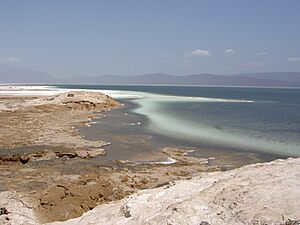Hypersaline lake facts for kids
A hypersaline lake is a special kind of body of water on land that has a lot more salt than the ocean. Imagine water so salty it feels thick! These lakes are filled with high amounts of sodium chloride and other salts, making them much saltier than regular ocean water, which is about 3.5% salt.
In these super salty places, some amazing tiny living things, called microbes, can actually survive and even thrive. Most other plants and animals can't live in such salty conditions. Some of these microbes are even thought to make certain lakes look pink! The water in hypersaline lakes is also very dense because of all the salt, which means things float much more easily in them.
You can find hypersaline lakes all over the world, especially in dry or semi-arid regions where water evaporates quickly, leaving the salt behind.
Contents
What is a Hypersaline Lake?
A hypersaline lake is a lake that contains a very high concentration of salts, much higher than the saltiness of the ocean. The word "hypersaline" means "extra salty." These lakes are usually found in places where water flows in but doesn't flow out to the sea. Instead, the water evaporates, leaving all the salts behind. Over long periods, this process makes the water incredibly salty.
Why Are They So Salty?
Hypersaline lakes become so salty because they are "endorheic," meaning they don't have an outlet to the ocean. Rivers and streams might flow into them, bringing dissolved salts from the surrounding land. However, water only leaves these lakes through evaporation. When water evaporates, it turns into vapor and rises into the air, but the salt stays behind in the lake. Over thousands of years, this continuous process leads to a massive buildup of salt, making the water extremely concentrated.
Life in Super Salty Water
Even though most living things can't survive in such salty conditions, some incredible microbes have adapted to call hypersaline lakes home. These special organisms are called halophiles, which means "salt-loving." They have unique ways to protect themselves from the high salt levels. Some halophiles are responsible for the vibrant colors you might see in these lakes, like bright reds, oranges, or even pink. Scientists have even found some of these tiny creatures that can go into a deep sleep-like state when the water dries up, and they are thought to be able to survive for millions of years!
Where Can We Find Hypersaline Lakes?
Hypersaline lakes are found on every continent, from the coldest places to the hottest deserts.
- In the Arctic, for example, there are two hidden hypersaline lakes under the Canadian Devon Ice Cap.
- Antarctica also has larger hypersaline lakes, like Lake Vanda in the McMurdo Dry Valleys, which is more than 10 times saltier than ocean water!
- Many are found in arid (very dry) or semi-arid (partially dry) regions around the world, where the hot sun causes water to evaporate quickly.
Famous Hypersaline Lakes Around the World
Let's explore some of the most famous and interesting hypersaline lakes on Earth.
The Saltiest of Them All: Gaet'ale Pond
The absolute saltiness champion of the world is the Gaet'ale Pond, located in the Danakil Depression in Afar, Ethiopia. Its water has an incredible salinity of 43%! This means it's about 12 times saltier than the ocean. Imagine trying to float in that! It's so salty that it's considered the saltiest natural water body on Earth.
Other Notable Salty Lakes
- Lake Assal in Djibouti was once thought to be the saltiness record holder outside of Antarctica. It has a salinity of about 34.8%, which is roughly 10 times saltier than ocean water.
- The Dead Sea is perhaps the most famous hypersaline lake. It sits between Israel, the West Bank, and Jordan. In 2010, its salinity was around 34.2%. The Dead Sea is also the world's deepest hypersaline lake. Its high salt content makes it incredibly easy to float, almost like magic!
- The Great Salt Lake in Utah, USA, is another well-known example. While it's much larger in surface area than the Dead Sea, it's also much shallower. Its saltiness can change a lot, from about 5% to 27%. At its lowest water levels, it can be nearly 7.7 times saltier than the ocean. But when it's full, its salinity drops to just a bit more than the ocean.
See Also
- Brine pool – A very salty area of water, often at the bottom of the ocean.
- Halophile – Organisms that love and thrive in very salty environments.
- List of bodies of water by salinity – A list comparing the saltiness of different water bodies.
- Pink lake – Lakes that get their pink or red color from special microbes.
- Salt lake – A general term for lakes with high salt concentrations.


